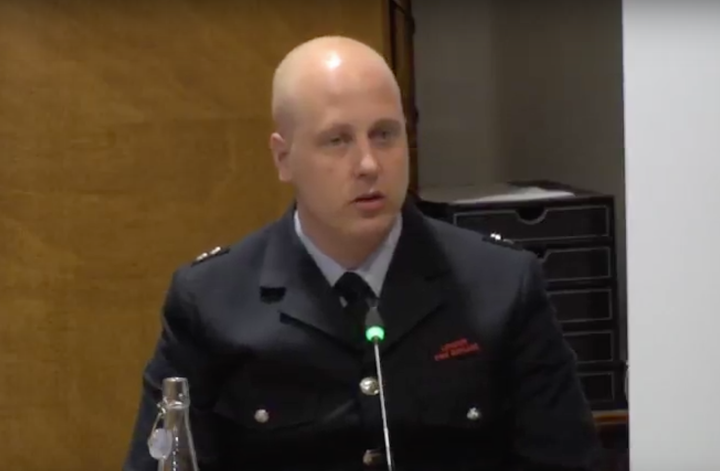One of the first firefighters on the scene of the Grenfell Tower disaster has blamed the refurbishment of the 24-storey high rise for helping the fire “jump” up the building’s cladding, creating a “war zone”.
Charles Batterbee, a crew manager at North Kensington fire station, was one of two firefighters tasked with extinguishing the blaze in flat 16 on the fourth floor on June 14 last year.
In a witness statement released on Thursday, the firefighter detailed how he was knocked down by burning debris and described the scene he encountered within the burning building as “hell”.
Batterbee told the Grenfell Tower Inquiry that he had visited the Lancaster West Estate tower in 2016 as it was undergoing refurbishment.
He said that “never in a million years” did he “expect there to be sandwich panels involved on a residential high rise building”.
Batterbee broke down in tears as thermal imaging footage taken of the moment he and colleague Daniel Brown entered the flat where the blaze broke out shortly after 1am was played.
When inquiry chairman Sir Martin Moore-Bick asked whether he felt able to watch the footage, Batterbee requested a break.
The firefighter left the room, wiping his eyes as he was led away by an usher.
It comes just days after Michael Dowden, a watch manager from the same station, had to be temporarily excused from the hearing after he became emotional while watching the approximate moment he realised the flames had spread to the building’s external facade, at about 1.19am.
In a written statement, Batterbee described in harrowing detail the scene faced by firefighters and outlined his previous experience dealing with high rise fires.
Batterbee said he had “never felt that level of heat before, either in training or operationally” as he approached the flames in flat 16.
“It felt like it had totally wrapped around me. The water we put in just turned to steam but I couldn’t see any glowing or flame,” he said.
Firefighters managed to extinguish the blaze inside the flat, but later noticed it had broken out through the window.
Batterbee then assisted his colleague, helping him climb on the counter to try to extinguish the blaze.
Debris began to fall from the building and the firefighter recalled seeing flames travelling upwards, getting increasingly worse.
“It then became clear that it was going up the building or at least higher than just the flat above. I remember the intensity of the flame. I can only describe it as huge balls of flame falling down along with debris; it didn’t stop; it was violent. I thought the fire was jumping quick and the debris were windows falling and window frames. We kept hitting it with water but again it was having no bearing on the fire.”
The pair left the flat before their breathing apparatus ran out. As he exited the tower, Batterbee said he encountered falling debris which “could quite easily kill a person”.
The crew manager, who joined the London Fire Brigade in 2010, said the scene was “like a war zone”.
“The noise was so loud with the fire, the constantly falling debris and the pumps going. There were times during the night when I was far enough away carrying out a task, where I would be able to see the entirety of the Tower and every time it was a hundred times worse than the time before. It shouldn’t have happened. It completely spread from being one face alight to eventually all faces alight. At one point, it looked like a massive line of fire had gone up and over the top of the building and down the West side. We had gone from a fire in a building to a building on fire.”

In a damning indictment of the refurbishment, Batterbee said that “the main thing that could have been in place that night to assist firefighters would have been a building not clad in highly flammable material”.
He told the inquiry he had attended the Shepherds Court fire in 2016, which ripped through five storeys of another west London high rise.
But Batterbee said he had never received any training on how to deal with a fire on the exterior of a high rise block before June 2017.
He told the hearing that most of his training was “generally classroom based” and involved drawing a tower on a whiteboard and discussing on arrival tactics.
He confirmed that, after the Shepherds Court fire, he did not receive any training or updates about lessons learnt in terms of fire spread on the exterior of buildings.
Earlier this week the inquiry heard Dowden had also received no training on evacuating tall buildings with a ‘stay-put’ policy.
Batterbee’s witness statement also revealed many harrowing details from the night of the blaze, including seeing the body of a person who had jumped from the burning high-rise.
“No matter where you looked there was things going on. It didn’t matter where you looked, it was just horror,” Batterbee’s statement read.
He also recalled a moment during the night when a man in his early 20s told him that there was a woman dangling a baby out of a window on the 11th floor.
The physical and mental toll placed on firefighters at the scene was also outlined in the witness statement, with crew members having to lie down due to heat exhaustion at the base of the stairs to the tower.
The inquiry continues.
